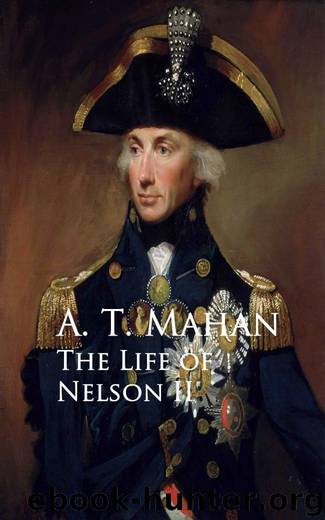The Life of Nelson II by A. T. Mahan

Author:A. T. Mahan [Mahan, A. T. (Alfred Thayer)]
Language: eng
Format: epub
Published: 2016-08-07T00:00:00+00:00
Map of Sardinia
During the previous war Nelson's attention had not been called much to Sardinia. Up to the withdrawal from the Mediterranean in 1796, Corsica had been a sufficient, and more suitable, base for the operations of the fleet, which until then had been upon the Riviera and the northern coast of Italy. When he returned in 1798, even after the Battle of the Nile and the disasters of the French in 1799, the unsettled condition of Naples, the blockade of Malta, and the affairs of Egypt, had combined to keep him in the South; while the tenure of the Allies in Northern Italy, up to the Battle of Marengo, was apparently so secure as to require no great support from the fleet. Irrespective of any personal influences that may have swayed him, Sicily was better suited then to be the centre from which to superintend the varied duties of his wide command.
When he returned in 1803, the old prepossessions naturally remained. In a survey of the political conditions written for the Prime Minister when on the passage to Toulon, much is said of Malta, Sicily, and Naples, but Sardinia is dismissed with a passing hope that the French would not seize it. After joining the fleet off Toulon, however, he had to realize that, if it was to remain at sea, as he purposed and effected, and yet be kept fully provisioned and watered, it must at times make an anchorage, which should be so far convenient as to keep it, practically, as much on its station as when under way. In this dilemma his attention was called to the Madalena Islands, a group off the northeast end of Sardinia, where wood and water could be obtained. Between them and the main island there was a good harbor, having the decisive advantage of two entrances, by one or other of which it could be left in winds from any quarter. A survey had been made a year before, during the peace, by a Captain Ryves, now commanding a ship in the fleet. As winter approached, Nelson decided to examine the spot himself, which he did in the last days of October, taking advantage of a moonlight week when the enemy would be less likely to leave port. He found it admirably adapted for his purposes, and that fresh provisions, though not of the best quality, could be had. "It is certainly one of the best anchorages I have met with for a fleet," he wrote, "but I suppose the French will take it now we have used it." This they did not attempt, and the British fleet continued to resort to it from time to time, obtaining water and bullocks.
Such a roadstead as an occasional rendezvous, where transports could discharge their stores to the vessels, and ships be refitted and supplied, would make the fleet as secure of holding its position as were the cruisers that depended upon Malta and Gibraltar. Its being two hundred miles from Toulon was not a serious drawback, for it was no part of Nelson's plan to keep the fleet close to Toulon.
Download
This site does not store any files on its server. We only index and link to content provided by other sites. Please contact the content providers to delete copyright contents if any and email us, we'll remove relevant links or contents immediately.
Fanny Burney by Claire Harman(26526)
Empire of the Sikhs by Patwant Singh(22974)
Out of India by Michael Foss(16791)
Leonardo da Vinci by Walter Isaacson(13181)
Small Great Things by Jodi Picoult(7019)
The Six Wives Of Henry VIII (WOMEN IN HISTORY) by Fraser Antonia(5394)
The Wind in My Hair by Masih Alinejad(5034)
A Higher Loyalty: Truth, Lies, and Leadership by James Comey(4843)
The Lonely City by Olivia Laing(4750)
The Crown by Robert Lacey(4723)
Millionaire: The Philanderer, Gambler, and Duelist Who Invented Modern Finance by Janet Gleeson(4376)
The Iron Duke by The Iron Duke(4291)
Papillon (English) by Henri Charrière(4195)
Sticky Fingers by Joe Hagan(4101)
Joan of Arc by Mary Gordon(4013)
Alive: The Story of the Andes Survivors by Piers Paul Read(3968)
Stalin by Stephen Kotkin(3875)
Aleister Crowley: The Biography by Tobias Churton(3588)
Ants Among Elephants by Sujatha Gidla(3417)
